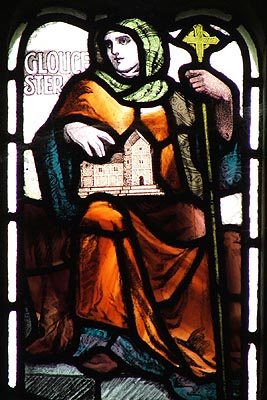
EBK Home
Kingdoms
Royalty
Saints
Pedigrees
Archaeology
King Arthur
Mail David
 St. Cuneburga
St. Cuneburgaof Gloucester,
Abbess of Gloucester
(c.AD 660-AD 710)
St. Cuneburga of Gloucester is a mysterious character. She was apparently the sister of King Osric of the Hwicce who founded the double monastery of St. Peter at Gloucester (now Gloucester Cathedral) in AD 681. Such monastic establishments contained both monks and nuns in separate, yet joint, communities under a ruling abbess. Osric appointed his sister,
Cuneburga, as the first Abbess of Gloucester. If Osric is accepted as the same as the King of Deira of that name - a distinct possibility, though an unfavoured theory today - then St.
Cuneburga of Gloucester was the daughter of King Alchfrith of Deira and his wife,
St. Cuneburga of Castor (Northants). She was born about AD 660.
It is said that a prestigious Royal marriage was arranged for the young
Cuneburga, presumably involving her abandoning her nunnery in Gloucester. To avoid leaving the service of God, she fled into hiding in the city where she was taken in as the servant of a baker. The baker soon wished to adopt her, but his wife was consumed with jealousy and, when the baker was out one day - 25th June AD 710 - she murdered
Cuneburga, chopped off her head and threw it into a well near the south gate of the city. When the husband returned home and called out to his maidservant, she replied from the well!
Cuneburga's body was taken up and buried near her Well. A chapel was built over the spot and it became a place of miracles. The lady was revered as a saint, pilgrims flocked to her side and the chapel became the centre of a major medieval hospital. Miracles did cease for a time, because of the irreverent behaviour of the lady's custodian, but
Cuneburga's popularity was restored when
Archbishop Courtenay ordered a new translation in 1390. When the hospital was finally suppressed, during the mid 16th century Dissolution of the Monasteries, Sir Thomas Bell, a wealthy local draper and MP, transformed the buildings into almshouses for six poor men and St.
Cuneburga was all but forgotten.
